Santa Rosa Community Health family physician Erin Lund has long specialized in treating addiction in pregnant and post-partum patients, a fragile population with often challenging health needs who have frequently endured trauma, abuse, and domestic violence. In 2015, she founded the New Beginnings Clinic at the health center to help this vulnerable patient group.

New Beginnings, which offers three half-day clinics a week at the health center’s Vista and Caritas campuses, supports around 140 pregnant and postpartum patients annually who have active or in remission substance use disorders or complex social histories. Additionally, the clinic follows the children of these patients through at least their first year of life before transitioning them to other primary care providers at the health center.
Equally important, New Beginnings is a multidisciplinary program that includes a rotating team of doctors, including family medicine residents, and a core team of nurses and medical assistants, as well as a case worker and social worker. The health center views pregnancy and early parenting as an opportunity to help patients stop or manage their substance use, address their social health needs, and benefit from trauma-informed care without stigma or judgment, while also building resilience and well-being among patients and staff alike.
As Lund explains it, it doesn’t just take a health center team to help this population. It takes a village. She recalls a consultation with a recent patient that required the combined efforts of around 18 people from various community, government, and medical agencies on a one-hour call to help coordinate her care. The high-risk, unhoused pregnant patient currently has an active substance use disorder, acute health issues and is experiencing significant mental health symptoms that led to questions of competency with regard to caring for herself and her future newborn. Clearly, that’s not the kind of patient who can be sorted in a 15-minute routine clinic visit, and interagency collaboration is essential.
And, equally clearly, it takes compassion, sensitivity, and patience to navigate such complex health needs in a client. Given the New Beginnings Clinic’s mission and the patients it serves, it was a no-brainer then to formalize its adverse childhood experiences (ACEs) screening and response work as a member of CCI’s Resilient Beginnings Network.
Santa Rosa Community Health has long been recognized as a leader in ACEs screening and resilience work. The health center was selected to participate in the California ACEs Learning and Quality Improvement Collaborative (CALQIC), a partnership begun in July 2020 between CCI and the UCSF Center to Advance Trauma–Informed Health Care. A key learning from that collaboration: trauma happens in the context of relationships, and healing happens in relationships, too.
When the health center first began its ACEs training, it learned that ACEs screenings can bring up staff members’ own histories as care teams hear people’s traumatic stories. So early on, the center realized it needed to “walk the talk” of incorporating trauma-informed principles and taking time to hold space for staff, according to Deirdre Bernard-Pearl, former medical director at the pediatrics and teen campuses at Santa Rosa Community Health.
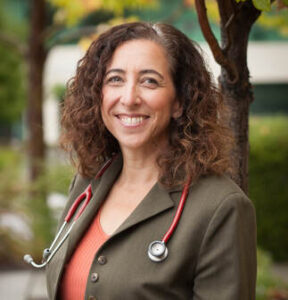
Deirdre Bernard-Pearl, MD.
“Healing happens when we practice medicine without judging our patients — when we get to know them more fully — including if there were awful things that happened to them,” noted Bernard-Pearl in an ACEs Aware blog post in May 2023. “When patients feel respected and not blamed, they engage in care. For many of the staff, ACEs screening has been very meaningful,” added Bernard-Pearl who currently serves on the California Surgeon General’s ACEs Aware Trauma-Informed Primary Care Advisory Committee.
ACEs screening and response for all
The California Surgeon General’s office has made screening for ACEs and addressing toxic stress a core priority. Launched in 2019, the state’s ACEs Aware initiative was created to train primary care providers to routinely and consistently screen pediatric patients for ACEs. The movement for childhood trauma screening has emerged because a landmark CDC-Kaiser Permanente study and many others link ACEs to an increased risk for a host of medical conditions including diabetes, heart disease, cancer, depression, substance use, and suicide.
The fallout from ACEs is costly. Researchers have found the annual health-related costs of ACEs and toxic stress in California to be $112.5 billion a year, which includes both health care spending and what’s known as “disease burden.” Disease burden includes premature death and years of productive life cut short by disability.
Santa Rosa Community Health is one of the largest not-for-profit organizations in Sonoma County. The network’s eight campuses serve around 40,000 patients including some in homeless shelters, and provides primary health care and education to underserved people in the community, regardless of their ability to pay. More than half the patients are of Latino background, about 50% prefer a language other than English, and many struggle with problems of poverty such as hunger, unstable housing, and a lack of transport. About 2,000 of these patients experienced homelessness in the past year and over 500 received substance use disorder treatment.
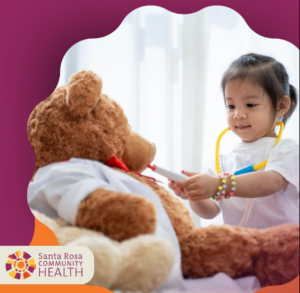
Given the needs of the community it serves, the heath center has been an early adopter of ACEs screening. ACEs screening and treatment has the potential to lower the risk of chronic disease and keep ACEs from being passed from one generation to the next, according to the CDC. In addition, researchers have found that positive childhood experiences, support, and strengths-based counseling can reduce and even reverse the impact of ACEs and toxic stress.
That’s where the New Beginnings Clinic hopes to make a difference. The clinic creates a bridge to patients through a healing approach based on listening, care, trust, empathy, compassion, dignity, and mutual respect. It’s a work in progress and, to be frank, it can drain even the most educated and empathic of practitioners.
To support staff well-being, the clinic team meets one hour a week to both discuss clinic challenges and to highlight positive patient experiences and engagement. The meetings are helpful, in part because issues come up that the team might not have anticipated and it gives the care team a designated time to address such matters, explains Lund. It serves as a reminder to team members to find ways to accentuate the positive in even the toughest patient situations and collaborate to find solutions to systems challenges that staff encounter.
The clinic has also held two off-site, half-day retreats with the goal of team members connecting outside of the stress and pace of work. Lund led the team through icebreakers and bonding activities to promote engagement. There was time to enjoy nature and eat lunch together. One activity involved reflecting on a childhood photo shared with the group. Lund talked about losing her brother at 19, a vulnerable disclosure that was only possible, she says, because of the trust that has developed within the team. Lund says the health center management supports both the weekly meeting and occasional time away from clinic. In an action-packed clinic setting, such breaks are especially necessary at a time of staff burnout, pandemic-related upheaval and huge turnover in both medical assistants and providers.
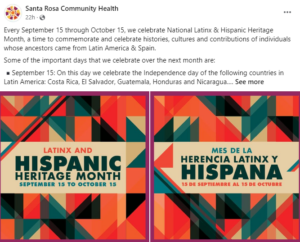
More than half the patients at SRCH are of Latino background, and many struggle with problems of poverty such as hunger and unstable housing.
The weekly staff meeting and retreats are opportunities to get to know care team members in a real way. Being trauma-informed starts with staff and helps to humanize the whole team, explains Lund. It also helps staff members talk with teammates and understand that each person on the team has their own unique set of strengths and challenges in and outside the workplace. That is, of course, also true for patients. Such events, adds Lund, are a gentle reminder to be kind and to see things from another person’s perspective.
The New Beginnings Clinic’s ACEs response includes undertaking TRIS training modules, which staff have reported helped them be more patient when dealing with clients. Some staff watched the videos at home; others watched together at work. The training reinforces what the clinic deals with on a routine basis and helps create a common language for talking about trauma-informed care, notes Lund. It also makes team members look at their implicit biases and helps to redefine and reshape the way staff interact with each other and the people they care for. Trauma-informed care and racial equity in health care are interwoven work in a health care setting, adds Lund.
The training acts as a guide for care team members and serves as a reminder that high-need patients are just people having very human experiences and to remember to have empathy even when staff are overwhelmed. It takes courage, notes Lund, to show up at a clinic for pregnant patients and new parents with substance use disorders. It’s important to thank patients for their honesty and vulnerability, which helps to validate them and underscore their value.
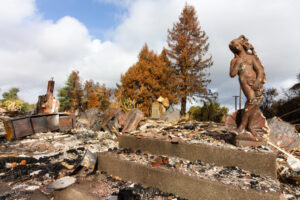
A wildfire in Santa Rosa in October 2017 destroyed more than 5000 homes, killed 22 people and burned part of Santa Rosa Community Health. (Credit: Shutterstock)
“This work is more important than ever because of how short-staffed and burned out everybody is,” adds Lund. “It’s very easily not made a priority because there are fires to put out literally and figuratively every day. The structure of regular meetings has allowed us to prioritize our program’s growth as a team.” It has also inspired them, she said, “to collaborate with others in our health center and outside agencies to keep working towards becoming more trauma-informed and healing in the care we all provide. This is important work to be spending time on in the middle of chaos.”
Equally important, she notes, it’s important to recognize when to hit pause and know that a goal isn’t going to be met—due to staff changes, clinic issues, natural disasters, a change in the electronic health record (EHR) system or a pandemic—and just understand that while the organization may not meet a certain measure during a quarter, centering the well-being of the team is vital, too. “Taking care of each other is more important than checking a box to say that you did something,” she says.
Reaching the most vulnerable community members
For instance, the team wants to work to retrain frontline staff and providers on ACEs screening workflows and to add questions that prompt the documentation of resiliency factors when providing ACES screening in an effort for the experience to be more strengths-based. That goal is currently on hold while the entire health center adjusts to a new EHR system. The team continues to work on using less stigmatizing language to discuss patients with substance use disorders and point out to each patient their unique strengths during the course of a visit. It can be something as simple as the fact that the patient made it to clinic and is willing to undergo care and treatment that day, says Lund. Or it might be something as significant as remaining abstinent from drugs or finding stable housing.
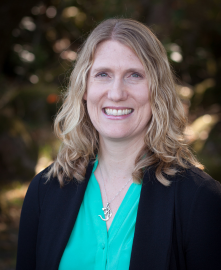
Dr. Erin Lund (Credit: faculty, Sutter Santa Rosa family medicine residency)
Staff have conducted paper surveys of patients to uncover what is helpful about the services they provide and how the clinic might improve the patient experience. But Lund says the most useful, actionable feedback has come from journey mapping with patients about their clinic experience. In either case, the message to patients is clear: We want to hear from you. And we value your feedback.
Mostly the responses were positive and a reminder that patients appreciate the clinic, staff, and the work they’re doing to maintain and improve their health. The staff feel that it’s important that patients have a voice and a place to express if what the care team is doing is effective and landing in the right way for them, and not just medically. It’s a chance for them to have agency in terms of cultural sensitivity and trauma-informed response, for instance.
One criticism, and one that cuts across the board at many health clinics: Patients expressed frustration at the length of time they wait at the clinic to see a provider after scheduling an appointment. Surveys and journey mapping helped the care team see that giving patients a distraction—prenatal guides, toddler storybooks, breastfeeding brochures—can help ease the irritation associated with lengthy waits. Snacks are also important for pregnant and lactating patients who may also be food insecure. Each clinic room now has a basket with these items, as well as phone chargers, as charged phones can help pass the time too. It doesn’t solve the waiting issue—the clinic is working on that—but it does help patients feel cared for while they are there.

The Caritas Campus provides family housing. (Burbank Homes/Facebook)
In January 2023, the health center expanded its New Beginnings Clinic to include serving unhoused in the community via Caritas Village’s Caritas Center, which includes a 200-bed family shelter run by Catholic Charities co-located on the health center’s Caritas campus. “Being in a clinic space that is adjacent to our largest family shelter in Santa Rosa is like a dream come true,” says Lund, who notes that for many patients the four walls of a clinic are too triggering. In addition, patients often lack reliable transportation, which makes it challenging to access clinic services.
The downtown Caritas Campus is easily accessed by public transportation. It is also co-located in a drop-in center where unhoused patients can access showers, hot food, and shelter from the elements in addition to housing services. The clinic team has already cared for several chronically unhoused patients who became pregnant who had not previously been willing to receive care elsewhere.
The new clinic also provides care for recently-arrived immigrant families who reside at the shelter and lack community support networks.
The clinic is not new to providing this kind of care. The Caritas clinic team already provides outreach at several shelter and permanent homeless encampments in Santa Rosa. In the next six months it plans to expand its street medicine outreach team even further to meet the most vulnerable patients where they are, which is often in the street. Lund hopes to be able to provide prenatal visits in the field for those not willing or able to come in for care with the goal of building trust and improving outcomes for both the pregnant patient and their fetus. The team has lost at least five patients in the last three years to overdose or other complications of chronic substance use, Lund recalls. Most of these patients were also unhoused with serious trauma histories. Lund and her team’s goal in providing street prenatal care is to engage patients in harm reduction approaches that can reduce their risk of death and hopefully connect them with opportunities to heal and recover.
The New Beginnings team also dedicates time to educating staff on the labor and delivery wards of local hospitals, public health nurses, and child welfare agency workers about substance use disorders in pregnancy to reduce stigma and bias and improve the inclusion of evidence-based practices in other settings. The New Beginnings team works with the Sonoma County Jail to care for any incarcerated patients who are pregnant. As Lund notes, there are only so many hours in the day and there is always more need for care and education of both patients and health professionals in the community.
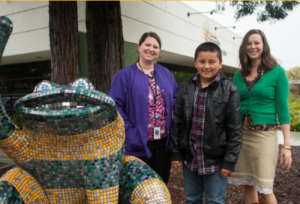
“Santa Rosa Community Health’s motto is “All of us. For all of you.” (Courtesy: SRCH)
Still, she celebrates the wins and the progress. “It’s brave for a pregnant patient to disclose their substance use during pregnancy,” says Lund, who is also a faculty member at the UCSF-affiliated Sutter Santa Rosa Family Medicine Residency program and engaged in educating the next generation of family doctors in a multidisciplinary model of care for treating patients with substance use disorders. She hopes the clinic and ACEs work will go a long way to prevent ACEs in the next generation, too. “While it’s true our team does see a lot of sadness and suffering, it’s also true that there is hope,” she says. “We see a lot of joy and stories of recovery every day. The narrative isn’t set. Pregnancy can offer a unique opportunity for patients to turn their lives around, and we have helped many pregnant people and new parents in the community do that. Their stories are what inspire me every day to keep doing this work.”
Lessons Learned
Carve out time for training. There are too many competing priorities in a safety net health center setting, so make a designated time for ACEs training to ensure that it actually happens. It could be individually or in groups—whatever works for staff—factor in a discussion time as well to make sense of and integrate learnings. Given staff turnover and new hires: Consider training an on-going activity not a one-off educational event. And set realistic goals with training: Don’t expect to cover all the training modules in one sitting.
Pilot training with a small group first. Figure out any kinks or concerns in a low-key way by starting with a small site or clinic before introducing the concept onto larger campuses. Begin with the providers who are the most interested in learning about ACEs. They can test out what they learn and share with the rest of the staff, and trainings can be tweaked accordingly.
Prioritize case manager roles. Team members who attend to patients outside of the clinic setting and follow up with appointment scheduling, resources, and other needs are crucial to the success of the New Beginnings Clinic. For instance, the clinic’s substance use disorder case manager spends time in local homeless encampments identifying and recruiting new patients and supporting current patients who are not consistently showing up for clinic appointments.
Meet patients where they are at—literally. There is immeasurable value, say team members, in facilitating in-the-field touch points and outreach. The ability to engage, screen, and treat patients who would otherwise not seek care at a clinic setting but will engage in treatment in, say, a shelter for the unhoused, reinforces how important it is to care for people in community.
Focus on resilience. Every patient has strengths. Before addressing challenges, find positives to single out-whether it’s engaging in care, securing stable housing, or entering a substance use program. Make a point of both verbalizing these “wins” to the patient and noting them in their chart. This strengths-based approach can have long-term impacts on a patient and their child’s health and welfare.
Santa Rosa Community Health is part of the Resilient Beginnings Network, a learning program that promotes trauma- and resilience-informed care so that 100,000 young children and their caregivers in the San Francisco Bay Area have the support they need to be well and thrive. The Resilient Beginnings Network is powered by the Center for Care Innovations, an Oakland-based nonprofit that fosters health equity and innovation in the health care safety net, and by Genentech Charitable Giving. Santa Rosa Community Health was a member of the 15-clinic cohort of CALQIC, which also included RBN teams Marin Community Clinics and Petaluma Health Center.
Find this useful or interesting? We’re constantly sharing stuff like this. Sign up to receive our newsletter to stay in the loop.

